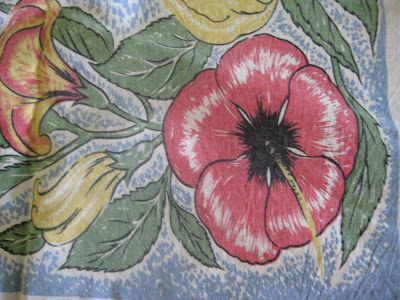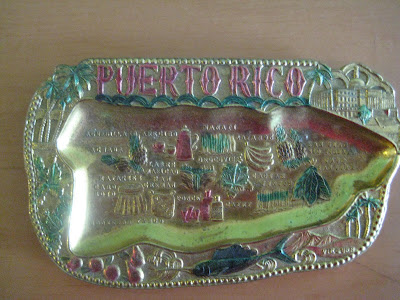










As someone of Puerto Rican descent, I have a fascination with touristy souvenirs depicting the Island. I have a collection of ashtrays shaped like the Island that depict its products and natural landmarks. I also have a priceless table cloth, probably from the early 1950s, that is part of a series made depicting products and flora of the 50 states of the USA. The Puerto Rican one was an add-on, and I am shocked that people were interested enough in the Island then, since now it seems to me that most US citizens are unaware that their country has a lovely Caribbean colony.
The table cloth depicts not only Island products - pinneaples, coffee, tobacco, but also US military bases, including the ones recently and thankfully removed from Vieques Island. US soldiers are shown doing military exercises. But what fascinates me the most are the historical parallels created by US imperialism and the Columbus' "discovery" of the Island. Three key moments of invasion are conflated - Columbus' arrival, the entry of US troops on the Island when they invaded in 1898, and the activities of the US army in bases at the time the table cloth was produced. I wonder who was buying this type of object, I assume it was US tourists going to the Island, eating macaroni and cheese on Sunday with their kids, a "Leave it to Beaver" suburban scenario, did they notice the violence depicted in their quotidian object?



 I think I need to start a new string sharing Art History schlock that I collect. This stuff was sent to me by my dear friend who lives in Amsterdam. From top to bottom: wrapping paper, and chocolates. Regarding the latter, my favorite ever find was a chocolate bar at the Reina Sofia Museum in Madrid, sadly no longer in production, whose wrapping reproduced Picasso's Guernica." Readers, please feel free to send me more!
I think I need to start a new string sharing Art History schlock that I collect. This stuff was sent to me by my dear friend who lives in Amsterdam. From top to bottom: wrapping paper, and chocolates. Regarding the latter, my favorite ever find was a chocolate bar at the Reina Sofia Museum in Madrid, sadly no longer in production, whose wrapping reproduced Picasso's Guernica." Readers, please feel free to send me more!











